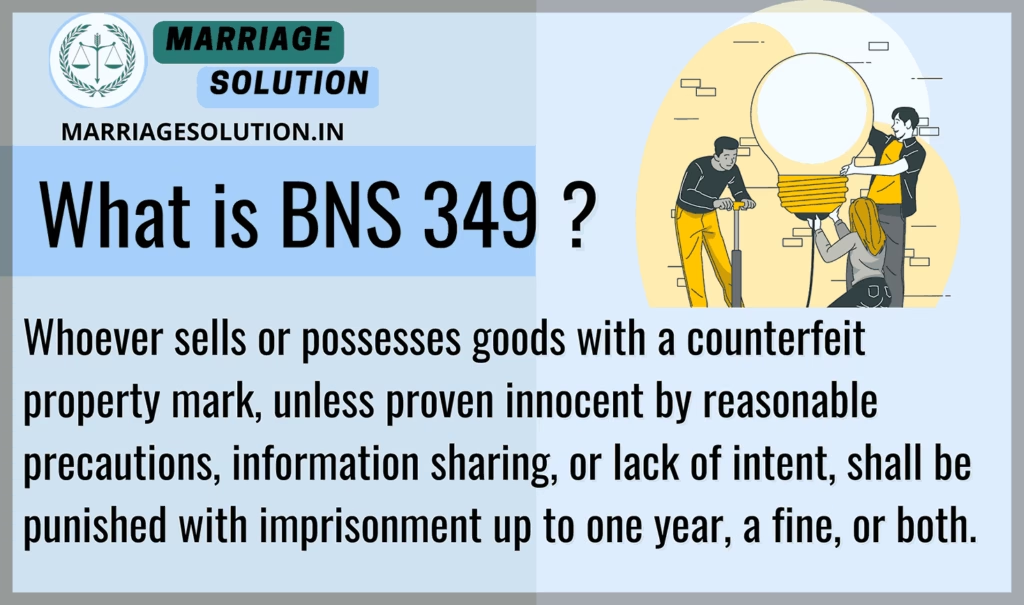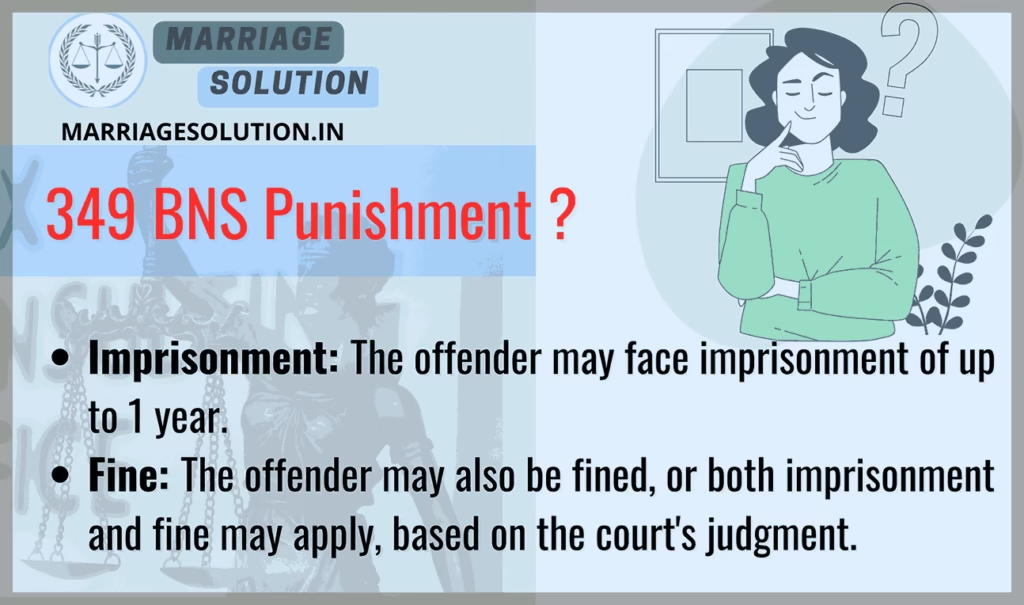Introduction of 349 BNS
349 BNS to curb the sale and possession of goods marked with counterfeit property marks. This provision ensures that sellers, traders, and distributors remain accountable for the authenticity of products they deal with. By replacing the old IPC Section 486, BNS 349 brings clarity and strengthens consumer protection against fake or fraudulent goods in the market. It not only safeguards genuine businesses from unfair competition but also preserves consumer trust in brands and trade practices.
The Bharatiya Nyaya Sanhita (BNS) Section 349 replaces the old Indian Penal Code (IPC) Section 486.
What is BNS Section 349 ?
Whoever sells or possesses goods with a counterfeit property mark, unless proven innocent by reasonable precautions, information sharing, or lack of intent, shall be punished with imprisonment up to one year, a fine, or both.

BNS 349 in Simple Points
“Whoever sells, exposes for sale, or possesses for sale any goods with a counterfeit property mark, unless they prove that they took reasonable precautions, acted without knowledge of the counterfeit nature, and provided complete information of the supplier when required, shall be punished with imprisonment up to one year, or with fine, or with both.”
1. Meaning of Selling Goods with Counterfeit Property Marks
- Property mark → A logo, symbol, stamp, or seal showing ownership or authenticity.
- Counterfeit property mark → A fake or forged mark created to imitate a genuine one.
- Application → If a shopkeeper sells or displays goods with fake logos (e.g., fake branded shoes), it falls under this section.
2. Essential Ingredient – Responsibility of the Seller
The seller must prove innocence by showing:
- They took reasonable precautions before selling.
- They had no reason to believe the goods were counterfeit.
- They provided full supplier details to authorities when asked.
This ensures honest sellers are protected while fraudulent sellers are punished.
3. Punishment under BNS Section 349
- Imprisonment → Up to 1 year.
- Fine → As decided by the Court.
- Both → Court may impose both, depending on severity.
4. Nature of the Offense
- Bailable → Accused can get bail as a matter of right.
- Non-Cognizable → Police need magistrate’s approval before arrest or investigation.
- Non-Compoundable → Cannot be settled privately, must go through trial.
- Trial by → Any Magistrate.
5. Examples of BNS Section 349 in Action
- Example 1 – Fraudulent Case (Punishable):
A shopkeeper knowingly sells shoes with a fake Nike logo. → Offense under Section 349. - Example 2 – Honest Seller (Not Punishable):
A trader buys goods from a supplier, unaware they are fake, and cooperates fully with authorities by sharing supplier details. → Not guilty under Section 349. - Example 3 – Preventive Action:
An electronics dealer reports counterfeit-marked items found in a shipment instead of selling them. → Protected under law.
6. Importance of Section 349
- Protects consumers from being cheated with fake goods.
- Maintains brand reputation and fair trade practices.
- Ensures accountability of sellers in the supply chain.
Section 349 BNS Overview
BNS Section 349 defines the offense as selling, displaying for sale, or possessing goods with counterfeit property marks. The offender can avoid punishment if they prove they took reasonable precautions, had no knowledge of the counterfeit mark, and provided all necessary information to the authorities.
10 Key Points with Detailed Explanation
1. Counterfeit Property Mark Defined
A counterfeit property mark is a false or fake mark that is deliberately made to look like a genuine one. These marks are used to deceive people by making counterfeit goods appear as authentic branded products. Such fake marks may copy logos, symbols, labels, or trademarks. The purpose is usually to cheat buyers, damage the reputation of genuine businesses, or gain unfair profit.
2. Scope of Offense
The law covers a wide range of activities related to counterfeit marks. It is not only an offence to manufacture counterfeit goods, but also to sell, offer for sale, expose for sale, or even possess goods with counterfeit property marks. This wide coverage ensures that counterfeit activity is punished at every stage, whether it is production, storage, or distribution.
3. Provisions for Innocence
The law also protects innocent sellers who unknowingly deal with counterfeit goods. A person accused of this offence can prove their innocence if they show:
- They took reasonable precautions to avoid selling counterfeit goods.
- They had no reason to suspect that the goods were counterfeit.
- They provided full details about the supplier or source of the goods when asked by authorities.
This ensures that only those with dishonest intent are punished.
4. Intent to Protect Consumers
The main goal of this section is to protect consumers from being cheated into buying fake products. Counterfeit goods can be unsafe, poor in quality, or harmful to health. By punishing counterfeit activities, the law makes sure that consumers receive genuine and safe goods. It also builds trust in the market, as buyers feel confident that their money is not being wasted on fake items.
5. Punishment for Violation
Anyone found guilty of using or dealing with counterfeit property marks can face imprisonment of up to one year, a fine, or both. This punishment acts as a warning to those who may think of engaging in counterfeit trade. It also serves justice by ensuring that offenders are held accountable for cheating both consumers and genuine businesses.
6. Bailable Offense
This offence is classified as bailable, which means that an accused person has the right to seek bail. This prevents unnecessary detention during the trial and balances the rights of the accused with the need for punishment if found guilty.
7. Non-Compoundable Offense
The offence of using counterfeit property marks is non-compoundable. This means it cannot be settled or withdrawn through an agreement between the parties involved. Once reported, it must go through the judicial process. This ensures that counterfeit crimes are taken seriously and not ignored through private settlements.
8. Jurisdiction of Trial
Cases under this section can be tried by any magistrate. This makes the trial process flexible and efficient, as it allows cases to be handled without unnecessary delays, regardless of location or complexity.
9. Protection for Sellers Acting in Good Faith
Sellers who unknowingly sell counterfeit goods are given protection if they cooperate with authorities. As long as they acted honestly, without intent to cheat, and provided details about where the goods came from, they will not be unfairly punished. This ensures that honest traders are not treated the same as deliberate counterfeiters.
10. Impact on Trade Practices
This section plays a major role in promoting fair trade practices. Counterfeit goods harm genuine businesses by reducing their sales and damaging their reputation. By punishing counterfeiters, the law safeguards genuine companies, encourages honest competition, and ensures that consumers benefit from authentic, high-quality goods.
Examples of Obeying BNS Section 349
- Example 1: A Clothing Store Owner Verifying Labels
A clothing store owner ensures all goods sourced from suppliers have genuine brand labels by verifying their authenticity before purchase. They refuse to sell items with counterfeit marks, thereby adhering to the law under BNS Section 349. - Example 2: A Consumer Electronics Dealer Reporting Counterfeit Goods
A dealer in electronics finds some gadgets with fake property marks while checking a new shipment. The dealer immediately informs the supplier and reports the counterfeit items to authorities to ensure compliance with BNS Section 349.
BNS 349 Punishment
Imprisonment: The offender may face imprisonment of up to 1 year.
Fine: The offender may also be fined, or both imprisonment and fine may apply, based on the court’s judgment.

BNS 349 bailable or not ?
Yes, offenses under BNS Section 349 are bailable, allowing the accused to apply for bail and avoid prolonged detention during trial proceedings.
Comparison: BNS Section 349 vs IPC Section 486
| Section | Offense | Punishment | Bailable / Non-Bailable | Cognizable / Non-Cognizable | Trial By |
|---|---|---|---|---|---|
| BNS Section 349 | Selling, exposing for sale, or possessing goods marked with a counterfeit property mark (unless innocence proven by reasonable precautions/supplier info). | Imprisonment up to 1 year, or fine, or both. | Bailable | Non-Cognizable | Any Magistrate |
| IPC Section 486 (Old) | Sale, exposure for sale, or possession for sale of goods marked with a counterfeit property mark. | Imprisonment up to 1 year, or fine, or both. | Bailable | Non-Cognizable | Any Magistrate |
BNS Section 349 FAQs
What is the main purpose of BNS Section 349?
It prevents the sale and distribution of goods with counterfeit property marks to protect consumers and promote fair trade practices.
Who can try cases under BNS Section 349?
The case can be tried by any magistrate, ensuring accessibility and prompt judicial process.
BNS 349 Is the offense bailable?
Yes, the offense is bailable, allowing the accused to apply for bail during legal proceedings.
What punishment is prescribed under this BNS 343?
The offender may be punished with imprisonment up to 1 year, a fine, or both.
Conclusion
BNS Section 349 plays a vital role in promoting fair trade and consumer safety by penalizing the sale of counterfeit-marked goods. It continues the intent of IPC Section 486 but places greater responsibility on sellers to ensure authenticity. By making the offense bailable and non-cognizable, the law balances protection for innocent sellers while ensuring punishment for fraudulent practices. Overall, Section 349 safeguards businesses, protects consumers, and upholds market integrity.
Need Legal Support?
If you are dealing with court cases, marriage problems, or any other legal issue, our team at Marriage Solution – Lawyer Help is here for you. Simply fill out our quick online enquiry form, and we’ll connect you with the right legal expert to support your needs.
Finished with BNS 349 ? Continue exploring the next provisions of the Bharatiya Nyaya Sanhita (BNS), 2023. Each section includes explanations, examples, and plain-language breakdowns for easy understanding.
- 350 BNS : Making a false mark upon any receptacle containing goods .
- https://marriagesolution.in/bns_section/350-bns/
Chapter XIX – Of Criminal Intimidation, Insult, Annoyance, Defamation, Etc.
- 351 BNS : Criminal intimidation .
- https://marriagesolution.in/bns_section/351-bns/
- 352 BNS : Intentional insult with intent to provoke breach of peace .
- https://marriagesolution.in/bns_section/352-bns/
- 353 BNS : Statements conducing to public mischief .
- https://marriagesolution.in/bns_section/353-bns/
- 354 BNS : Act caused by inducing person to believe that he will be rendered an object of the Divine displeasure .
- https://marriagesolution.in/bns_section/354-bns/
Full IPC Section List: https://marriagesolution.in/ipc-section-list
All Indian Law & Blogs: https://marriagesolution.in/indian-law/
Full BNSS Section List: https://marriagesolution.in/bnss_section-list
